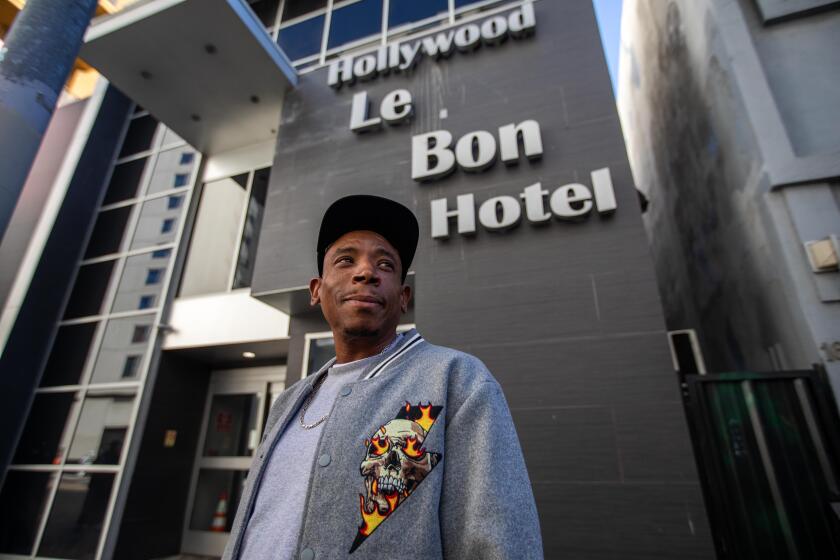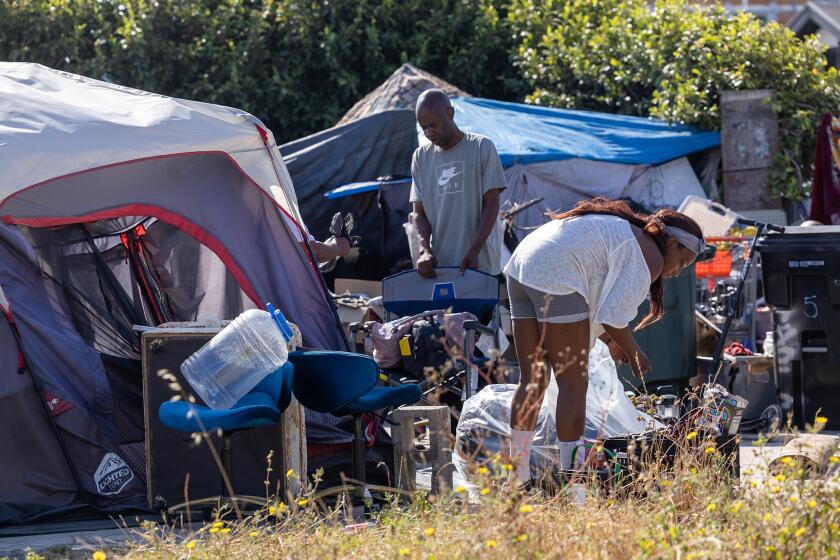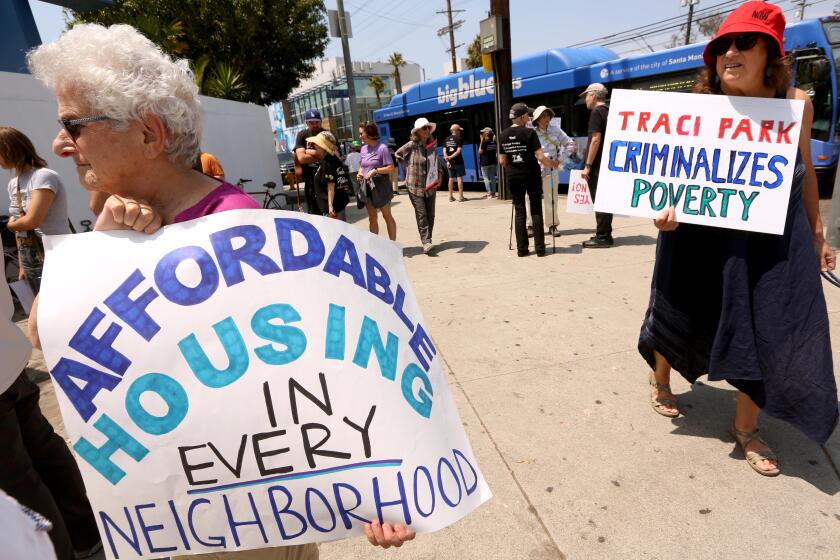
- Share via
In Paris, the French government packed homeless people and migrants onto buses and sent them out of the city as the Summer Olympics approached. In 2016, more than 70,000 were displaced from Rio de Janeiro’s favelas to make way for the event. And ahead of the Games in 1984, the Los Angeles Police Department saddled nearly three dozen mounted horse patrols to scatter homeless people into less visible areas downtown.
Now, in advance of the 2028 Olympics, Mayor Karen Bass is pledging that the city will not resort to such severe tactics to remove the tens of thousands living here without shelter.
“However our strategy evolves, it will always be housing people first,” Bass said in an interview Thursday. “It will never be putting people on a bus and shipping them out.”

In four years, the world’s spotlight will shine on Los Angeles and, most likely, an ongoing humanitarian crisis of homelessness. If L.A. is going to address the problem differently than other host cities — and itself in the past — Bass and other local, state and national leaders will have to accelerate the availability of housing and implement other strategies to stem the tide of Angelenos ending up on the streets.
After accepting the Olympic flag from Paris Mayor Anne Hidalgo at this week’s closing ceremonies, Bass said she’s already grappling with that reality.
As her Inside Safe program enters its second year, Bass said she is determined to clear the bottleneck keeping homeless residents from getting into permanent homes.
“The goal will be to significantly reduce street homelessness and significantly increase the move from interim [housing] to permanent,” she said.
Bass declined to offer specifics on her target, saying any number would be artificial four years before the Games. When L.A. was awarded the Olympics in 2017, Bass’ predecessor, Eric Garcetti, promised to cut street homelessness in half within five years and end it by 2028. Today, there are 16% more unsheltered people on any given night than in 2017, nearly 30,000 in total, according to annual counts of the homeless population.
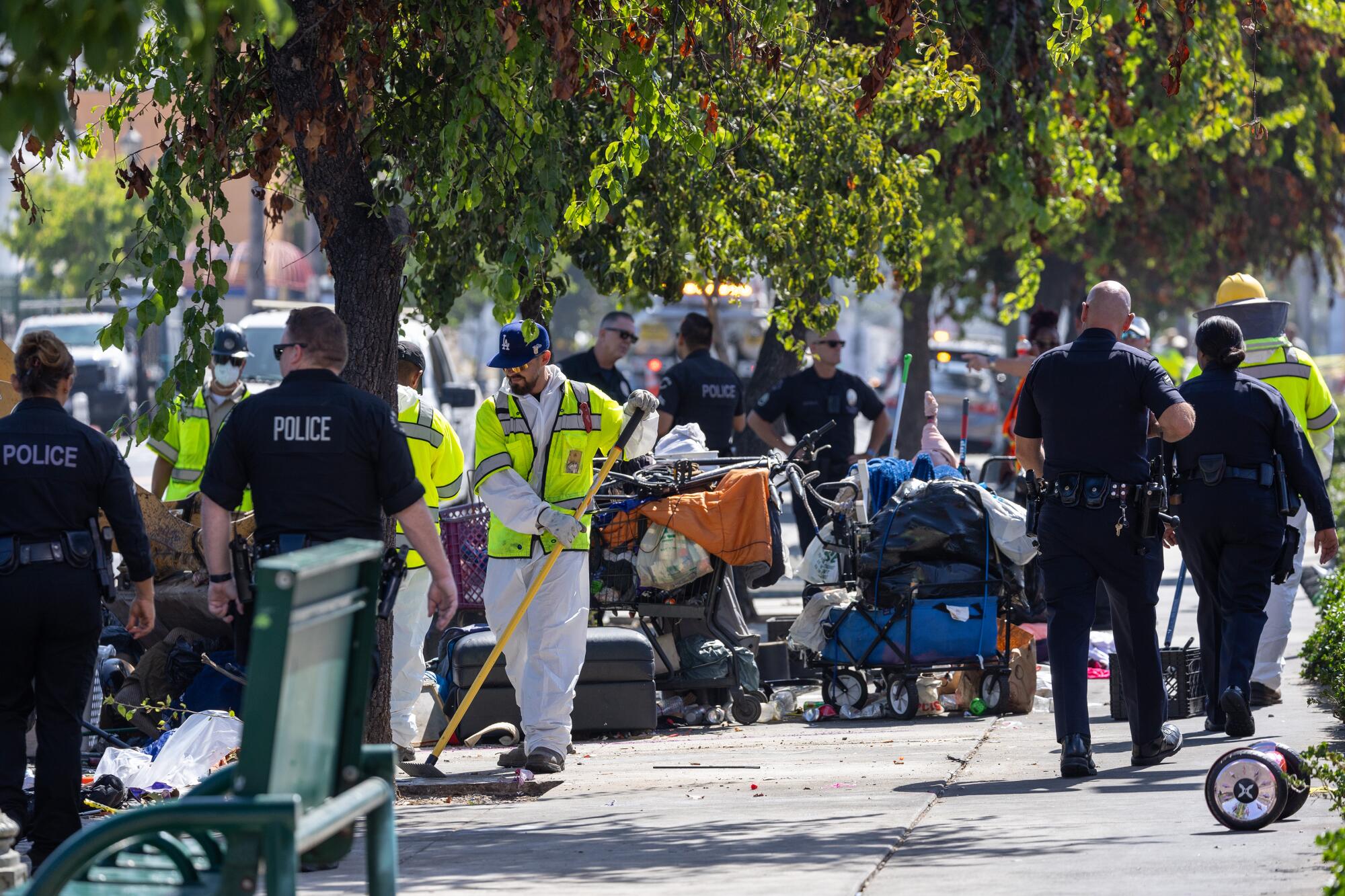
At the center of Bass’ approach is Inside Safe, an encampment-clearing program in which dwellers receive beds in hotels, motels and other types of temporary housing. By July 31, Inside Safe had moved more than 2,900 people indoors since it started in December 2022. (Of that total, about 28% had returned to homelessness, according to the Los Angeles Homeless Services Authority.)
On Thursday, Inside Safe moved another three dozen people out of a long-standing encampment along Hollywood Boulevard and into interim shelters.
The 2024 homeless count found the number of people living on Los Angeles city and county streets declined after five years of increases.
The program has faced a number of challenges, principally a lack of both interim and permanent housing supply, limiting the ability for people to enter the system and to transition from temporary hotel stays into stable homes. A number of encampments cleared by Inside Safe have simply repopulated, forcing multiple visits by outreach workers.
But the mayor and others have credited the program with helping the city change direction. This year’s homeless count saw the overall population decrease for the first time since 2018, highlighted by a 10% annual reduction in unsheltered homelessness. If cuts were to continue at a similar pace, then the unsheltered figure would fall to below 16,000 by the Olympics, just over half what it is now.
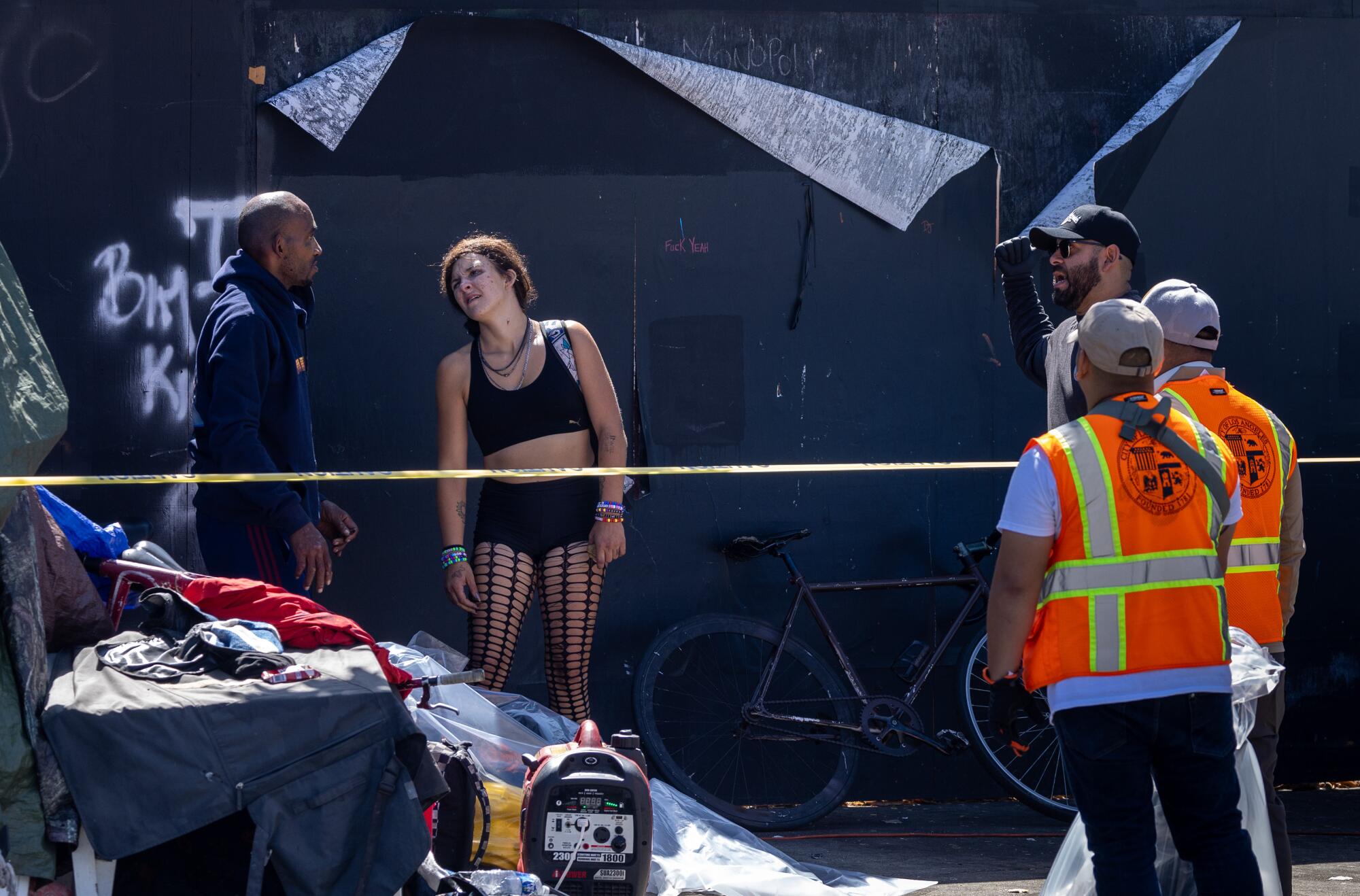
With Olympic venues spread across the region, it’s not just L.A. that will face greater scrutiny. SoFi Stadium and the Intuit Dome in Inglewood will host high-profile swimming and basketball events; Long Beach will get seven sports and Dignity Health Sports Park in Carson will get four. Last year’s countywide unsheltered population was 55,000, a reduction of 5% from the year before.
The crush of tourism will present its own challenges.
Gary Blasi, a professor emeritus at UCLA’s School of Law, said he expected motel owners will no longer want to contract with public agencies for rooms now being used for Inside Safe and related programs because they’ll be able to make so much more from visitors. In 1984, The Times reported that motel dwellers as far as Orange County were forced onto the streets because of Olympic guests.
“I can’t imagine that anybody with a motel will take $105 for a room from the city when they will have visitors from all over the world,” said Blasi, who represented homeless people and Skid Row residents as a legal aid lawyer in the 1980s.
The region will have to make dramatic changes to its approach, including increasing welfare or basic income payments and siting quickly built modular homes, to address the scale of the homelessness problem, he said.
“I do not think there is any chance that simply doing more of what we are doing now for the next four years will lead to anything but more misery for extremely poor and unhoused people and a historic embarrassment for Los Angeles,” Blasi said.
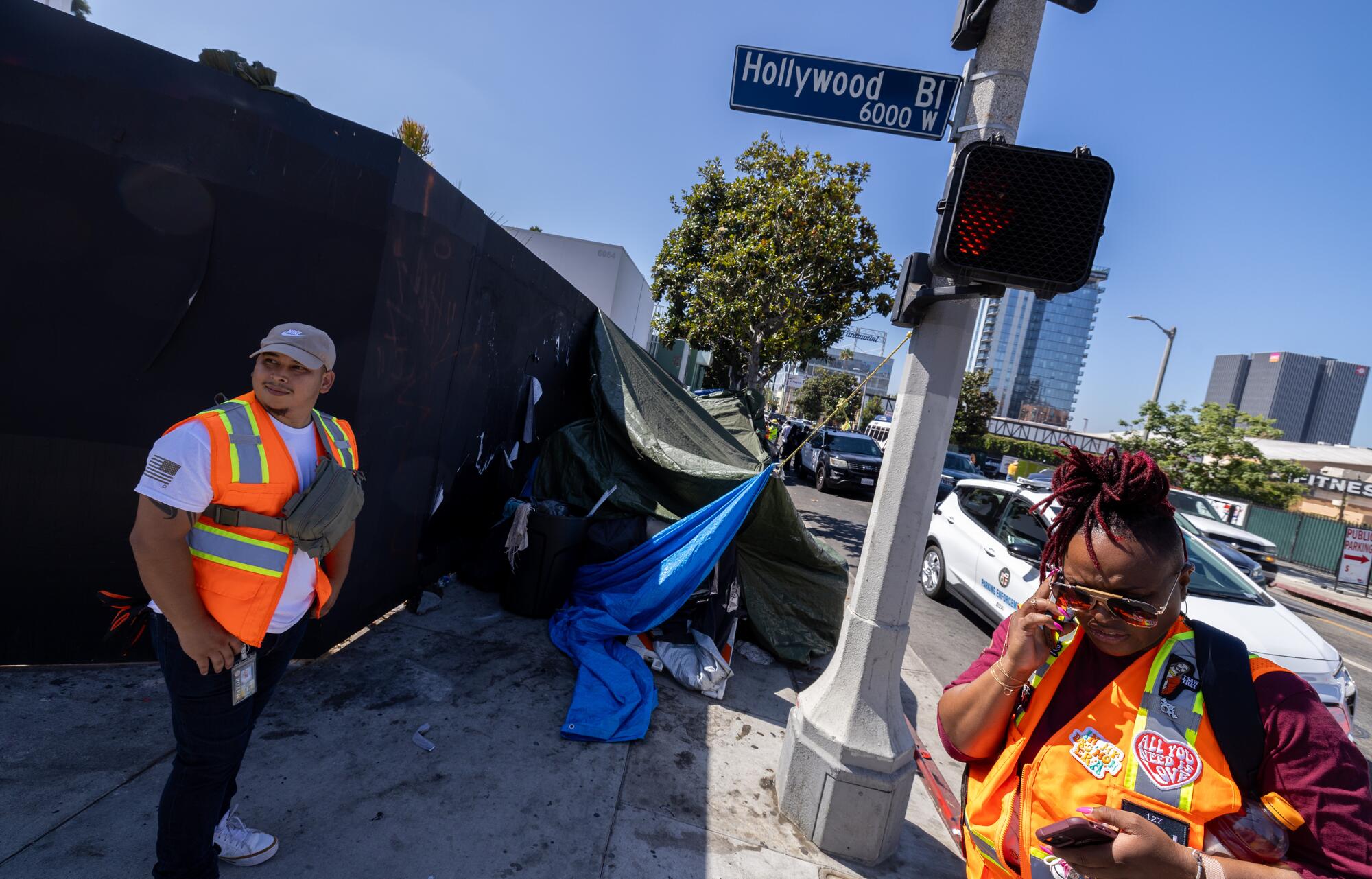
Bass also is concerned that hotel and motel owners won’t rent to the city during the Games and said her approach to homelessness is changing. She’s counting on the city to work more closely with the private sector to lease larger apartment buildings. She also expects that the supply of low-cost apartments will grow in the coming years, as part of her strategy for streamlining approval of affordable housing.
With this summer’s U.S. Supreme Court ruling allowing local governments greater ability to clear encampments even without available shelter space, Bass said she’s concerned that other communities could force their homeless populations into L.A. She’s preparing to unveil a regionally focused strategy to stop that from happening.
“What I’m trying to prevent is the shuffling of people,” Bass said.
She’s hoping that the state and federal government will continue to provide funding for the region’s homelessness challenges before the Games.
Human Rights Watch issued a voluminous report Wednesday castigating local officials and Gov. Gavin Newsom for failing to observe “an internationally protected human right” by criminalizing homelessness.
Gigi Droesch, an organizer with NOlympics LA, a coalition of left-wing and tenant groups formed in opposition to the city’s bid, said history shows that the Games will not only accelerate displacement of homeless Angelenos but also divert funding from needed housing programs toward policing and other security measures. The city’s current encampment-clearing efforts show that L.A. is headed in the same direction, she said.

“This happens every single Olympics,” Droesch said. “Los Angeles is not going to be special and they’ve already proven they’re not special.”
Kevin Murray, president and chief executive of Weingart Center, one of the region’s largest nonprofit landlords and homeless service providers, said that while he expects the Olympics will add external pressure on Bass to address homelessness, it won’t make her turn to a more heavy-handed approach.
“This mayor is just never going to do forced removals,” Murray said. “That’s not who she is.”
That is, of course, assuming she is still mayor. Bass’ 2026 reelection bid is just one of the political and economic uncertainties that will affect L.A.’s homelessness response. Money from Washington could depend heavily on who wins the presidential election in November, and which parties control the House and Senate. Gov. Gavin Newsom, who recently held a press event at an encampment cleaning in the San Fernando Valley where he threatened to pull money from local governments that didn’t act with sufficient urgency, will be termed out of office in 2026.
Some of the international attention to L.A.’s homelessness programs has started.
This week, Human Rights Watch, a U.S-based nonprofit that reports on human rights abuses around the globe, slammed Los Angeles for criminalizing homelessness and failing to observe an “internationally protected right” to adequate housing, and criticized Inside Safe and other local programs as too draconian.
Bass’ office responded by calling the report “cynical and disingenuous,” saying its authors want to take the city back to an era when “Black and brown people languish and die on 100-degree sidewalks.”
Times researcher Scott Wilson contributed to this article.
More to Read
Sign up for Essential California
The most important California stories and recommendations in your inbox every morning.
You may occasionally receive promotional content from the Los Angeles Times.
